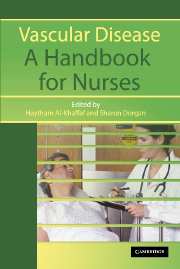1 - Outpatient Department
Published online by Cambridge University Press: 12 August 2009
Summary
PERIPHERAL ARTERIAL DISEASE
Peripheral arterial disease (PAD) is generally used to describe diseases of the arteries outside the heart and the brain. However, specifically it refers to atherosclerosis of the arteries that carry blood to the legs (and to a lesser extent to the arms).
ATHEROSCLEROSIS
Atherosclerosis is a complex and insidious condition, and one of the primary causes of death in the UK.
Generally, arteries have smooth linings, allowing unimpaired blood flow. Atherosclerosis is a degenerative arterial disease and refers to “hardening of the arteries”, whereby muscle and elastic tissues are replaced with fibrous tissue, and calcification might occur.
It is characterised by atheromatous plaques, which are deposits of fatty material in the lining of medium- and large-sized arteries. These arteries then become narrowed and rough as more fat is deposited. Blood clots form more easily due to their roughness, further narrowing the artery, and thus potentially limiting blood flow.
A reduction of blood supply to the organs and tissues means that they are unable to perform as well, and the plaques are very liable to break down and form ulcers. Thromboses may then develop as a result of the roughening and ulceration of the inner coat of the arteries (Figure 1.1.1).
- Type
- Chapter
- Information
- Vascular DiseaseA Handbook for Nurses, pp. 1 - 88Publisher: Cambridge University PressPrint publication year: 2005



